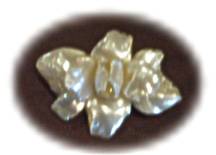|
What Exactly are Natural Pearls?In the summer of 2004, Michael and Philip, friends of mine, who live on the shores of the Mississippi River near Muscatine, Iowa, gathered some clams to use for fishing bait... they got more than fishing bait... they found three "wild" pearls for their mother! The Pearl Button Capitol of the World Museum in Muscatine, Iowa, displays several pearls, such as the ring above, which were found during the pearl button rush in the early part of this century when the shells were more sought after than the pearls. Pearls were sold by the pound to buyers who came through.
Read this true "Pearls Before Swine" story. I know a lady who has large Tupperware containers full of non-cultured pearls harvested from the Mississippi River. Last Christmas I sold a pink pearl necklace, bracelet and earring set to a man who dives for clams in the Mississippi River. After seeing a large, lovely, pink pearl found by a fellow diver, he was anxious to have a pink pearl necklace for his wife. Another clam diver from Iowa told me he usually finds elongated black pearls in the Mississippi River...pearls he wouldn't even think of selling. The Mississippi River, along with other rivers and lakes in the USA produce "angel wing" pearls which are very collectible.
 Natural Mississippi River Pearl Pin on display at Muscatine Button Museum
So....what is a natural? It's just that...natural,or "wild" occurring in nature without any intervention of man. This is the explanation from the Mikimoto Pearl Island Museum at Toba, Japan. Mikimoto was instrumental in the development of cultured pearls...trust me, these guys know their pearls. "How Naturals are Formed"Of all the parts of the body of a pearl only the mantle lobe (tissue) can secrete the pearl substance called nacre. The part of the middle lobe that can do this is located just under the shell. When, for various reasons, some of these outer cells get into a deeper part of the tissue, the mother oyster begins to grow a bog called a "pearl sac." This pearl sac then begins to secrete nacre and a pearl is formed. Non-cultured pearls then, are the result of the pearl sacs being formed without human intervention.
Read about the working of the pearl mantle here. Non-cultured pearls develop naturally in wild mollusks although few contain pearls. A 6mm pearl can take 10 years to grow and the time needed to increase it even 1-2mm increases exponentially while chances of harming its beauty also increases. Non-cultured pearls are essentially all nacre, or pearl substance with no substantial nucleus. However, tissue nucleated Chinese freshwater cultured pearls can also be all nacre, as compared with most cultured pearls which have a nucleus which is often a mother-of-pearl bead from a clam found in a USA river. Up until the end of the 19th Century, little was known of pearls that were other than "natural pearls." When you see the ancient paintings of queens and kings of the 19th Century and before with ropes of pearls....they were non-cultured pearls which were generally only available to the wealthy. Read about Pearls in history Or about Pearls of Royalty. Even today, fine non-cultured pearls carry high prices..if you can even find any for sale. However, you will probably see ads on this page for natural pearls, as they are once more being sought after and becoming prized once again because of the current flood of cultured pearls on the market. Natural pearls will only become increasingly popular and more and more valuable. It will take some knowledge however, to be able to tell which ones are truly natural and not cultured. How to tell a natural. There are four ways to tell a natural pearl....click here for a page describing those four ways. Interestingly, just when natural supplies were dwindling, the cultured pearl industry rose significantly. Why were naturals becoming scarce? One reason was depletion of oyster population. Pollution and industrialization also took their toll. Because pearl diving, only done by humans, is hazardous, other jobs became more popular and better paying, especially after oil was discovered in the Persian Gulf. Pearl diving can be hazardous and not yield much success. A diver can find only a handful of natural pearls over his lifetime. The Pearl, an enchanting story of a Mexican pearl diver by John Steinbeck, illustrates the glory and accompanying peril of finding a "Pearl of all Pearls." Because natural pearls are well...natural, they tend to be not perfect. Therefore, often a necklace of non-cultured pearl will not be recognized for the valuable piece it is...so keep your eyes open for these treasures that often sell at auctions at far below their value.
Scotland, it's said, was sought after by the Roman legions because of its freshwater pearls and perhaps that's the reason for its invasion of England. What is the present state of pearling in Scotland? Find out here. A famous pearl, the Abernathy Pearl, was discovered in Scotland, in 1967, by pearl diver, William Abernathy, and now is on display in Perth. Read more about this pearl and other famous wild pearls here. Natural freshwater pearls (called Margaritas) tend to be whiter than natural sea pearls (often called Orients or Orientals), although, as mentioned above, freshwater non-cultured pearls can also be other colors such as pink and black. While other gems need cutting and polishing....a natural pearl comes to us complete in natural beauty, a finished product.
Abalone pearls
|











